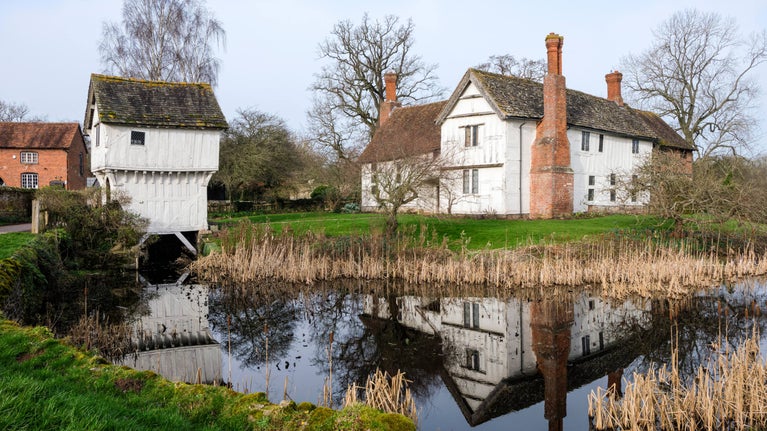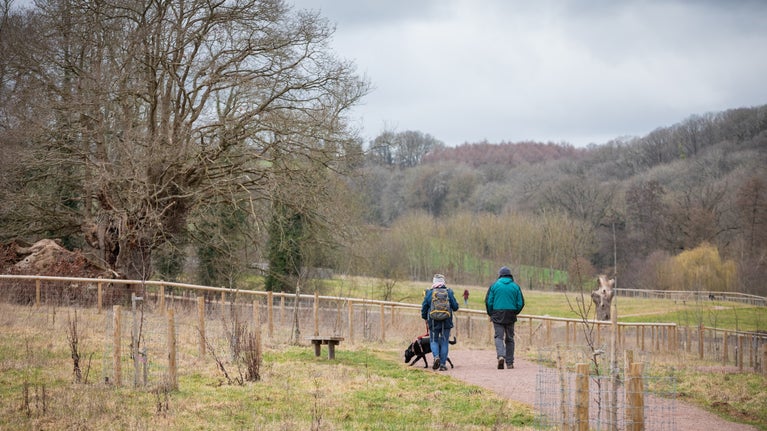
Discover more at Brockhampton
Find out when Brockhampton is open, how to get here, the things to see and do and more.

The moated manor house may be the highlight of the Brockhampton estate, but did you know there’s plenty to see and discover in the wider parkland? The estate at Brockhampton covers 1,700 acres and includes wooded valleys, streams and woodlands, all changing with the seasons.
There are four waymarked walks to choose from at Brockhampton where you can immerse yourself in the beauty of nature. The walks include a mix of accessible paths and off road paths. Discover orchards, both old and new, natural woodland, parkland and a circular walk with breathtaking views across the Herefordshire countryside.
Enjoy sweeping views across the county and beyond, to Bringsty Common, the Clee Hills, Cotswolds and Malvern Hills. This short walk takes you on a circular route around the top of the estate, taking in the church, Park Pond and glimpses of what used to be the walled garden for the Georgian house.
Explore the natural green space on a trail through the woodland with the family. The woodland was once part of the Leggett-inspired parkland. Some of the large older specimen trees were planted in the late 1700s as part of this re-design. Why not see how many native trees you can spot during your walk? Just remember to pop on your wellies, as the paths are very muddy at this time of year
Explore the accessible paths through the young and old orchards, which are home to rare wildlife with something of interest in every season. Spring blossom displays give way to boughs laden with autumn fruit. Mistletoe thrives in the older fruit trees which can easily be seen in winter. This 1½-mile return walk is a treat for the senses whatever time of year you visit.
This is a challenging but enjoyable walk around the Brockhampton estate's Grade II-listed parkland. The many veteran trees here are home to a variety of wildlife, while work has been carried out around the lawn pool to open up some of the original views to and from the Georgian mansion house.
Come prepared - This route can get quite muddy in wet weather, so make sure you bring suitable footwear.
An overview showing all the walks is available
The parkland at Brockhampton was converted from farmland into the picturesque landscape style made popular by Lancelot ‘Capability’ Brown. Here are some highlights to look out for while you explore the outdoors.
The estate at Brockhampton is dog-friendly with. Find out all you need to know here: Bringing your dog to Brockhampton
Brockhampton boasts an impressive 700 acres of woodland containing over 32 species of trees. Clustered in steep-sided valleys next to the streams, and to the north of the estate, are pockets of semi-natural ancient woodland. To be classed as ‘ancient’ the area must have been continuously wooded since 1600 and some of the wide-bottomed oaks are at least 500 years old.
Whilst walking through the woods, depending on the time of year you may see bluebells, snowdrops, daffodils, primroses and sweet woodruff. Less commonly seen, though still present, are wood spurge and dog’s mercury.
Once trees have died or fallen, we leave the decaying trunks that make great habitats for insects, fungi and lichens.
Records show that Lawn Pool has existed here since around 1769 when Leggett designed the parkland surrounding the mansion. It would have provided the perfect spot for the Barnebys to fish and shoot, and in the 1800s it also had its own boathouse.
Today, Lawn Pool is a wildlife haven where you can enjoy watching carp, frogs and coots. If you’re really lucky you may spot a kingfisher.

At the top of the estate near the welcome kiosk stands Brockhampton Chapel. This Chapel was was built between the years 1790-1810 as a replacement for the Old Noman Chapel, which is now a ruin situated next to the moated Manor House at Lower Brockhampton.
The present Chapel takes the form of an ‘Early Gothic Revival’ stone church predating any such church in Hereford and London by 20 years, with tower and pinnacles, buttresses with saddleback heads and an embattled parapet. The Chapel is open to visitors from 10am to 5pm, and you are welcome to head in an explore durning your visit.
The estate is home to approximately 145 acres of traditional orchards. Whatever the season, don't miss the impressive elderly fruit trees which engulf the medieval manor house and beyond.
Surrounding the house is an orchard full of Shropshire prune damson trees which erupt into cloud-like blossom around early April, followed by laden boughs of sweet fruit by late summer.
Head through the gate and the damson trees begin to intermingle with apples, many local heritage varieties grow here such as the Onibury Pippin and Worcester Pearmain.
Other fruit on the estate include cherries, pears and the not-so-common medlar fruit which dates back to the Roman times. You have to wait for this fruit to ‘blett’ or rot, before it is sweet and soft enough to eat.
As the weather turns cooler, resident farmer James Hawkins grazes his Hebrides sheep here to help manage the orchards organically.
Archaeological investigations in 2015 confirmed knowledge that a large orchard, spanning over 21 acres once stood in the grazing fields behind the manor house.
In 2019, we began reinstating these lost Victorian orchards but with a modern twist. Bristol-based artist, Walter Jack, was commissioned to help create an orchard with the enjoyment of visitors at the heart of its design.
Working alongside landscape architects, Rathbourne Partnership, Walter developed a concept of the orchards which will span across three fields.
The first of the orchards was planted in winter 2019 and can now be explored by visitors. This orchard features five ‘circular rooms’ surrounded by lowland meadow.
Each ‘room’ features unusual and rare varieties of fruit, specially chosen to tell the story of the history of the eating apple, from its origins in Kazakhstan to the traditional Herefordshire cider apple.
The story of the apple will also be told through different means of interpretation and art, the first installation being the 'Hereford Bull' trow (type of cargo boat) which can be discovered in the new orchards. After exploring the trow, follow the accessible paths along the orchard play trail, spot the orchard wildlife sculptures and find out more about the importance of these priority habitats.
Not only are orchards significant to Herefordshire’s past, but they also create wonderful habitats which is why the National Trust is working hard towards preserving and maintaining the orchards at special places in Herefordshire.

Find out when Brockhampton is open, how to get here, the things to see and do and more.
The estate at Brockhampton is dog-friendly, with miles of woods and parkland to explore with your four-legged friends. Here’s everything you need to know about bringing your dog.

Uncover 600 years of history inside this timber framed manor house and learn how it evolved to meet the different needs of different generations who lived there.

At the heart of the estate lies Lower Brockhampton Manor house, a late 14th century timber-framed house, surrounded by a moat and entered via a timber-framed gatehouse.

Find out the places you can rest and refuel or treat yourself to a pre-loved book to take home at Brockhampton. From classic favourites in the café to pre-loved stories in the second-hand bookshop, every penny spent in the café or shop helps us to look after Brockhampton for future generations.

Find out more about the work the team are doing to care for wildlife at Brockhampton and our traditional orchards.

Explore some of the finest landscapes in our care on coastal paths, accessible trails, woodland walks and everything in between. Find the best places to walk near you.

Click here for a PDF version of the Croft Castle walks map. All walks and trail routes can be found in the 'Things to see and do' section of our website.